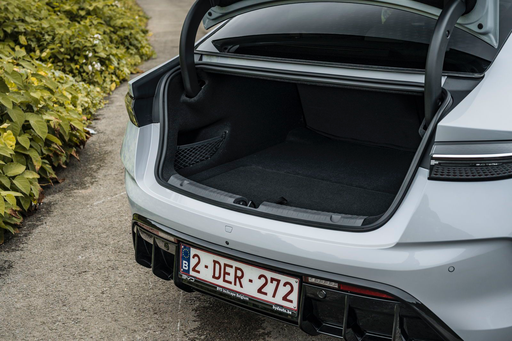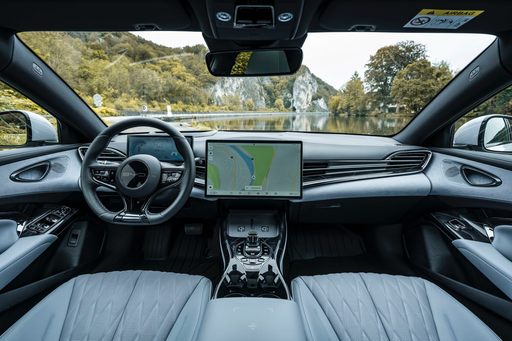BYD Seal vs smart #5 - Differences and prices compared
Costs and Efficiency:
Price and efficiency are often the first things buyers look at. Here it becomes clear which model has the long-term edge – whether at the pump, the plug, or in purchase price.
smart #5 has a slight advantage in terms of price – it starts at 39300 £, while the BYD Seal costs 40300 £. That’s a price difference of around 935 £.
In terms of energy consumption, the advantage goes to the BYD Seal: with 15.40 kWh per 100 km, it’s somewhat more efficient than the smart #5 with 18.40 kWh. That’s a difference of about 3 kWh.
As for range, the smart #5 performs barely noticeable better – achieving up to 590 km, about 20 km more than the BYD Seal.
Engine and Performance:
Under the bonnet, it becomes clear which model is tuned for sportiness and which one takes the lead when you hit the accelerator.
When it comes to engine power, the smart #5 has a a bit edge – offering 646 HP compared to 530 HP. That’s roughly 116 HP more horsepower.
In acceleration from 0 to 100 km/h, the is quicker – completing the sprint in , while the takes . That’s about faster.
In terms of top speed, the BYD Seal performs slight better – reaching 220 km/h, while the smart #5 tops out at 210 km/h. The difference is around 10 km/h.
There’s also a difference in torque: smart #5 pulls hardly perceptible stronger with 710 Nm compared to 670 Nm. That’s about 40 Nm difference.
Space and Everyday Use:
Cabin size, boot volume and payload all play a role in everyday practicality. Here, comfort and flexibility make the difference.
Seats: offers more seating capacity – vs .
In curb weight, BYD Seal is to a small extent lighter – 1907 kg compared to 2200 kg. The difference is around 293 kg.
In terms of boot space, the smart #5 offers noticeable more room – 630 L compared to 400 L. That’s a difference of about 230 L.
When it comes to payload, smart #5 slight takes the win – 502 kg compared to 473 kg. That’s a difference of about 29 kg.
Who wins the race?
The smart #5 proves to be wins solidly and therefore becomes our DriveDuel Champion!
smart #5 is the better all-rounder in this comparison.

smart #5
Costs and Consumption
View detailed analysis
Engine and Performance
View detailed analysis
Dimensions and Body
View detailed analysis
BYD Seal
The BYD Seal is a sleek electric fastback that punches above its class with sporty looks and a surprisingly premium cabin, offering a very modern alternative for buyers who want style and substance without the badge snobbery. On the road it feels composed and eager, packed with tech and everyday practicality—ideal for shoppers after eco-friendly performance with a cheeky wink.
details @ BYD Auto / BYD Global Media
@ BYD Auto / BYD Global Media
 @ BYD Auto / BYD Global Media
@ BYD Auto / BYD Global Media
 @ BYD Auto / BYD Global Media
@ BYD Auto / BYD Global Media
 @ BYD Auto / BYD Global Media
@ BYD Auto / BYD Global Media
 @ BYD Auto / BYD Global Media
@ BYD Auto / BYD Global Media
smart #5
The Smart #5 continues to build on the brand's legacy of compact and efficient urban vehicles, now infused with a more modern and stylish design. Its sleek appearance is complemented by a spacious interior, offering comfort without compromising its compact nature. This model is ideal for city dwellers seeking a blend of innovation, practicality, and style in their daily drives.
details
 @ BYD Auto / BYD Global Media
@ BYD Auto / BYD Global Media
|
|
|
|
|
Costs and Consumption |
|
|---|---|
|
Price
40300 - 45400 £
|
Price
39300 - 52200 £
|
|
Consumption L/100km
-
|
Consumption L/100km
-
|
|
Consumption kWh/100km
15.4 - 18.2 kWh
|
Consumption kWh/100km
18.4 - 19.9 kWh
|
|
Electric Range
460 - 570 km
|
Electric Range
465 - 590 km
|
|
Battery Capacity
-
|
Battery Capacity
74.4 - 94 kWh
|
|
co2
0 g/km
|
co2
0 g/km
|
|
Fuel tank capacity
-
|
Fuel tank capacity
-
|
Dimensions and Body |
|
|---|---|
|
Body Type
Sedan
|
Body Type
SUV
|
|
Seats
5
|
Seats
5
|
|
Doors
4
|
Doors
5
|
|
Curb weight
1907 - 2185 kg
|
Curb weight
2200 - 2378 kg
|
|
Trunk capacity
400 L
|
Trunk capacity
630 L
|
|
Length
4800 mm
|
Length
4695 mm
|
|
Width
1875 mm
|
Width
1920 mm
|
|
Height
1460 mm
|
Height
1705 mm
|
|
Max trunk capacity
-
|
Max trunk capacity
1530 L
|
|
Payload
446 - 473 kg
|
Payload
475 - 502 kg
|
Engine and Performance |
|
|---|---|
|
Engine Type
Electric
|
Engine Type
Electric
|
|
Transmission
Automatic
|
Transmission
Automatic
|
|
Transmission Detail
Reduction Gearbox
|
Transmission Detail
Reduction Gearbox
|
|
Drive Type
Rear-Wheel Drive, All-Wheel Drive
|
Drive Type
Rear-Wheel Drive, All-Wheel Drive
|
|
Power HP
231 - 530 HP
|
Power HP
340 - 646 HP
|
|
Acceleration 0-100km/h
3.8 - 7.5 s
|
Acceleration 0-100km/h
3.8 - 6.9 s
|
|
Max Speed
180 - 220 km/h
|
Max Speed
200 - 210 km/h
|
|
Torque
360 - 670 Nm
|
Torque
373 - 710 Nm
|
|
Number of Cylinders
-
|
Number of Cylinders
-
|
|
Power kW
170 - 390 kW
|
Power kW
250 - 475 kW
|
|
Engine capacity
-
|
Engine capacity
-
|
General |
|
|---|---|
|
Model Year
2023 - 2025
|
Model Year
2025
|
|
CO2 Efficiency Class
A
|
CO2 Efficiency Class
A
|
|
Brand
BYD
|
Brand
smart
|
What drive types are available for the BYD Seal?
The BYD Seal is available as Rear-Wheel Drive or All-Wheel Drive.
The prices and data displayed are estimates based on German list prices and may vary by country. This information is not legally binding.
